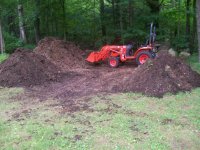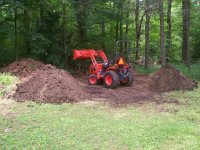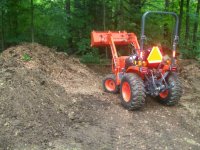That all depends a bit on the weather. If it is really wet, things can get soggy, and it then helps a lot to turn it, and get some air into it. The idea is to keep it hot inside so that it breaks down quickly. When I'm on the ball, I turn it every couple of weeks in the summer, and can have finished compost before the summer is over, our "summer" is three months, or so. In the fall when I'm getting ready to collect the leaves, I let the grass grow a bit longer so I get more "greens" in the mix. They have a higher nitrogen content, and heat things up quickly. I tend to get larger quantities of material at once, but not continually so that is why you see the three piles there. All are in different stages of decomposition. I have a small pile of very fine finished compost that I use around flowers, and small seeds, etc. This fall, I put the large pile that was left all on one garden. It wasn't quite finished, but I know that being tilled into the soil over the winter will fiinish the job, and it will be nice in the spring. It was steaming pretty good when I used the loader to move it to the garden. When I got the timing on turning right, and had some help from the winter, I've seen the piles steaming through the snow. It gets really cold here sometimes in the winter ( I've seen -35 degrees several times in my life) so the piles don't do much then, but you won't have that problem, and should be able to make compost year round. You can buy a compost thermometer with a long probe to monitor the interior temperature of the piles, but I never have.
If the piles don't seem to heat up at all (unlikely) they are probably too wet, too dry, or just don't have any "greens" at all in them. With a little trial, and error, you will figure it out quickly, and it will be great fun with your tractor! Higher, deeper piles work better than low, wide ones. That is one of the things that frequent turning helps with since things like leaves settle quickly, and get matted.



